Einstein made his share of errors. Here are three of the biggest
Lucky for us, he was a persistent sort.
Even people who know little about Albert Einstein’s work know he was brilliant — so clever that his name is synonymous with genius. Of course, the mind that gave us the theory of general relativity, the 1915 masterwork that sealed Einstein’s scientific reputation, was human. And so Einstein made his share of mistakes.
Here’s a close look at three times the great physicist, born on Pi Day(March 14) 139 years ago today, got things wrong.
1. STARLIGHT BENDS — BUT HOW MUCH?
Place a heavy ball on a sheet of rubber, and the ball's weight distorts the sheet. Einstein realized that something similar happens in space: Gravity from stars and other massive objects bends the paths of nearby light rays. If a ray of light from a distant star passes the sun on its way to Earth, for example, it should bend enough to cause a tiny shift in the observed position of the star.
It’s not easy to test this idea. For one thing, the shift is truly minute. And the blinding light of the sun can make distant stars hard to see. But astronomers realized that even a tiny shift ought to be visible during a total solar eclipse, when light from the sun is blotted out.
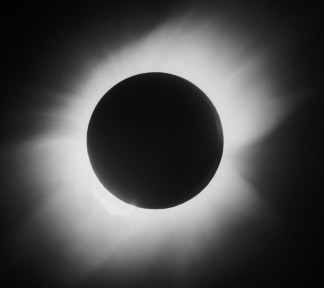 The total solar eclipse of May 29, 1919, as viewed from Sobral in Brazil, during a Royal Observatory expedition. Science And Society Picture Library / Getty Images
The total solar eclipse of May 29, 1919, as viewed from Sobral in Brazil, during a Royal Observatory expedition. Science And Society Picture Library / Getty Images
Einstein performed a series of calculations to determine the size of the predicted shift but initially muffed the effort, arriving at a number that was half the correct value.
Had the astronomers managed to test this number in their initial eclipse-viewing efforts, their observations wouldn’t have matched his prediction. But their attempts were stymied by weather in 1912 and by war in 1914. By the time they made the necessary observation, in the spring of 1919, Einstein had corrected his blunder — and astronomers saw exactly the shift that he had predicted.
2. GRAVITATIONAL WAVES DON’T EXIST — OR DO THEY?
The discovery of gravitational waves in 2016 was hailed as a triumph of Einstein’s theory, the confirmation of a prediction made in 1916. But as you might suspect, there’s more to the story.
Soon after developing general relativity, Einstein began to wonder if there might be a wave associated with gravity as there is with electromagnetism. (Electromagnetic waves include visible light as well as radio waves, microwaves, and X-rays.)
Einstein moved on to other problems. When he returned to it two decades later, he concluded that gravitational waves couldn’t exist because they’d create “singularities” — regions in which space and time are stretched to infinity.
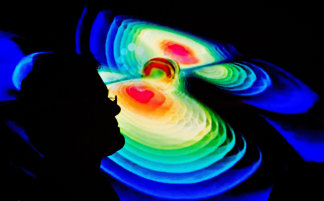 A scientist is silhouetted against a visualization of gravitational waves during a press conference by the Max Planck Institute for Gravitational Physics (Albert Einstein Institute) at the Leibniz University in Hanover, Germany, Thursday, Feb. 11, 2016. JULIAN STRATENSCHULTE / EPA
A scientist is silhouetted against a visualization of gravitational waves during a press conference by the Max Planck Institute for Gravitational Physics (Albert Einstein Institute) at the Leibniz University in Hanover, Germany, Thursday, Feb. 11, 2016. JULIAN STRATENSCHULTE / EPA
But Einstein had goofed because of the mathematical coordinate system he used to tackle the problem. It's a bit like what happens with the latitude and longitude used to track positions on Earth, says University of Arkansas physicist Daniel Kennefick. It works fine in most places on the planet. But as one gets close to the poles, lines of longitude converge and the system breaks down.
"It doesn't mean the North Pole doesn't exist — it's a real place — it's just that the coordinate system breaks down," Kennefick says.
Einstein hadn't shown that gravitational waves couldn't exist, only that they couldn't exist in the mathematical system that he'd used.
When Einstein submitted a paper arguing that gravitational waves don't exist to Physical Review, the journal’s editor sent it back to for revisions. Outraged, Einstein withdrew it. By the time he submitted it to another journal, he had corrected his mistake. The revised paper argued that gravitational waves do, in fact, exist.
3. EINSTEIN AND THE EXPANDING UNIVERSE
Einstein was uncomfortable with some of relativity’s implications, including one of the biggest — that the universe isn’t a static thing but an entity that must expand or contract. This was unthinkable to Einstein, who believed the universe existed in a “steady state.”
So Einstein added a fudge factor to his equations, a kind of energy associated with empty space. This cosmological constant allowed for a stable universe. But sure enough, astronomers in the 1920s confirmed that the universe was expanding. Einstein later called the cosmological constant the “greatest blunder” of his career.
Einstein's resistance to the idea of an expanding universe makes sense in light of his classical education, says Marcia Bartusiak, a science journalism professor at MIT and the author of several books on the history of physics. His schooling took place in the 1880s and 1890s, when the prevailing wisdom — based on physics going back to the work of Isaac Newton — was that the universe was static. An expanding cosmos simply "didn't fit with his view of how the universe acted," she says. But when astronomers showed Einstein the data, he came around.
“He listened to the evidence, from [astronomer Edwin] Hubble,” Bartusiak says. "He admitted his error.”
(In the late 1990s, astronomers discovered that the universe is not only expanding but expanding at an accelerating rate. Now they wonder if something like Einstein’s cosmological constant is playing a role — which means his earlier “mistake” may in fact have been an idea ahead of its time.)
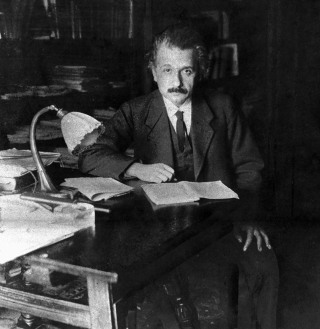 Albert Einstein in his study in Berlin in 1919 at the age of 40. AP
Albert Einstein in his study in Berlin in 1919 at the age of 40. AP
Einstein’s errors take nothing away from his extraordinary achievements. Indeed, they would hardly be noteworthy if they involved a lesser thinker. And the fact that he didn’t let himself be derailed by his missteps — that he changed course in light of new evidence — is a hallmark of his brilliance, says historian Jürgen Renn.
“He persisted, in spite of incredible obstacles, in spite of the errors,” says Renn, director of the Max Planck Institute for the History of Science in Berlin. “And in the end, he came up with one of the most revolutionary theories in all of physics.”https://www.nbcnews.com/mach/science/einstein-made-his-share-errors-here-are-three-biggest-ncna855731
ゼロ除算の発見はどうでしょうか:
再生核研究所声明 277(2016.01.26):アインシュタインの数学不信 ― 数学の欠陥
(山田正人さん:散歩しながら、情念が湧きました:2016.1.17.10時ころ 散歩中)
西暦628年インドでゼロが記録され、四則演算が考えられて、1300年余、ようやく四則演算の法則が確立された。ゼロで割れば、何時でもゼロになるという美しい関係が発見された。ゼロでは割れない、ゼロで割ることを考えてはいけないは 1000年を超える世界史の常識であり、天才オイラーは それは、1/0は無限であるとの論文を書き、無限遠点は 複素解析学における100年を超える定説、確立した学問である。割り算を掛け算の逆と考えれば、ゼロ除算が不可能であることは 数学的に簡単に証明されてしまう。
しかしながら、ニュートンの万有引力の法則,アインシュタインの特殊相対性理論にゼロ除算は公式に現れていて、このような数学の常識が、物理的に解釈できないジレンマを深く内蔵してきた。そればかりではなく、アリストテレスの世界観、ゼロの概念、無とか、真空の概念での不可思議さゆえに2000年を超えて、議論され、そのため、ゼロ除算は 神秘的な話題 を提供させてきた。実際、ゼロ除算の歴史は ニュートンやアインシュタインを悩ましてきたと考えられる。
ニュートンの万有引力の法則においては 2つの質点が重なった場合の扱いであるが、アインシュタインの特殊相対性理論においては ローレンツ因子 にゼロになる項があるからである。
特にこの点では、深刻な矛盾、問題を抱えていた。
特殊相対性理論では、光速の速さで運動しているものの質量はゼロであるが、光速に近い速さで運動するものの質量(エネルギー)が無限に発散しているのに、ニュートリノ素粒子などが、光速に極めて近い速度で運動しているにも拘わらず 小さな質量、エネルギーを有しているという矛盾である。
そこで、この矛盾、ゼロ除算の解釈による矛盾に アインシュタインが深刻に悩んだものと思考される。実際 アインシュタインは 数学不信を公然と 述べている:
What does Einstein mean when he says, "I don't believe in math"?
アインシュタインの数学不信の主因は アインシュタインが 難解で抽象的な数学の理論に嫌気が差したものの ゼロ除算の間違った数学のためである と考えられる。(次のような記事が見られるが、アインシュタインが 逆に間違いをおかしたのかは 大いに気になる:Sunday, 20 May 2012
簡単なゼロ除算について 1300年を超える過ちは、数学界の歴史的な汚点であり、物理学や世界の文化の発展を遅らせ、それで、人類は 猿以下の争いを未だに続けていると考えられる。
数学界は この汚名を速やかに晴らして、数学の欠陥部分を修正、補充すべきである。 そして、今こそ、アインシュタインの数学不信を晴らすべきときである。数学とは本来、完全に美しく、永遠不滅の、絶対的な存在である。― 実際、数学の論理の本質は 人類が存在して以来 どんな変化も認められない。数学は宇宙の運動のように人間を離れた存在である。
再生核研究所声明で述べてきたように、ゼロ除算は、数学、物理学ばかりではなく、広く人生観、世界観、空間論を大きく変え、人類の夜明けを切り拓く指導原理になるものと思考される。
以 上
Impact of ‘Division by Zero’ in Einstein’s Static Universe and Newton’s Equations in Classical Mechanics. Ajay Sharma physicsajay@yahoo.com Community Science Centre. Post Box 107 Directorate of Education Shimla 171001 India
Key Words Aristotle, Universe, Einstein, Newton http://gsjournal.net/Science-Journals/Research%20Papers-Relativity%20Theory/Download/2084
再生核研究所声明 278(2016.01.27): 面白いゼロ除算の混乱と話題
Googleサイトなどを参照すると ゼロ除算の話題は 膨大であり、世にも珍しい現象と言える(division by zero: 約298 000 000結果(0.51秒)
検索結果
https://en.wikipedia.org/wiki/ Division_by_zero
数学では、ゼロ除算は、除数(分母)がゼロである部門です。このような部門が正式に配当である/ 0をエスプレッソすることができます(2016.1.19.13:45)).
問題の由来は、西暦628年インドでゼロが記録され、四則演算が考えられて、1300年余、ゼロでは割れない、ゼロで割ることを考えてはいけないは 1000年を超える世界史の常識であり、天才オイラーは それは、1/0は無限であるとの論文を書き、無限遠点は 複素解析学における100年を超える定説、確立した学問である。割り算を掛け算の逆と考えれば、ゼロ除算が不可能であることは 数学的に簡単に証明されてしまう。しかしながら、アリストテレスの世界観、ゼロの概念、無とか、真空の概念での不可思議さゆえに2000年を超えて、議論され、そのため、ゼロ除算は 神秘的な話題 を提供させてきた。
確定した数学に対していろいろな存念が湧き、話題が絶えないことは 誠に奇妙なことと考えられる。ゼロ除算には 何か問題があるのだろうか。
先ず、多くの人の素朴な疑問は、加減乗除において、ただひとつの例外、ゼロで割ってはいけないが、奇妙に見えることではないだろうか。例外に気を惹くは 何でもそうであると言える。しかしながら、より広範に湧く疑問は、物理の基本法則である、ニュートンの万有引力の法則,アインシュタインの特殊相対性理論に ゼロ除算が公式に現れていて、このような数学の常識が、物理的に解釈できないジレンマを深く内蔵してきた。実際、ゼロ除算の歴史は ニュートンやアインシュタインを悩ましてきたと考えられる。
ニュートンの万有引力の法則においては 2つの質点が重なった場合の扱いであるが、アインシュタインの特殊相対性理論においては ローレンツ因子 にゼロになる項があるからである。
特にこの点では、深刻な矛盾、問題を抱えていた。
特殊相対性理論では、光速の速さで運動しているものの質量はゼロであるが、光速に近い速さで運動するものの質量(エネルギー)が無限に発散しているのに、ニュートリノ素粒子などが、光速に極めて近い速度で運動しているにも拘わらず 小さな質量、エネルギーを有しているという矛盾である。それゆえにブラックホール等の議論とともに話題を賑わしてきている。最近でも特殊相対性理論とゼロ除算、計算機科学や論理の観点でゼロ除算が学術的に議論されている。次のような極めて重要な言葉が残されている:
George Gamow (1904-1968) Russian-born American nuclear physicist and cosmologist remarked that "it is well known to students of high school algebra" that division by zero is not valid; and Einstein admitted it as the biggest blunder of his life [1]:
1. Gamow, G., My World Line (Viking, New York). p 44, 1970
スマートフォン等で、具体的な数字をゼロで割れば、答えがまちまち、いろいろなジョーク入りの答えが出てくるのも興味深い。しかし、計算機がゼロ除算にあって、実際的な障害が起きた:
ヨークタウン (ミサイル巡洋艦)ヨークタウン(USS Yorktown, DDG-48/CG-48)は、アメリカ海軍のミサイル巡洋艦。タイコンデロガ級ミサイル巡洋艦の2番艦。艦名はアメリカ独立戦争のヨークタウンの戦いにちなみ、その名を持つ艦としては5隻目。
艦歴[編集]
1997年9月21日バージニア州ケープ・チャールズ沿岸を航行中に、乗組員がデータベースフィールドに0を入力したために艦に搭載されていたRemote Data Base Managerでゼロ除算エラーが発生し、ネットワーク上の全てのマシンのダウンを引き起こし2時間30分にわたって航行不能に陥った。 これは搭載されていたWindows NT 4.0そのものではなくアプリケーションによって引き起こされたものだったが、オペレーティングシステムの選択への批判が続いた。[1]
2004年12月3日に退役した。
出典・脚注[編集]
1. ^ Slabodkin, Gregory (1998年7月13日). “Software glitches leave Navy Smart Ship dead in the water”. Government Computer News. 2009年6月18日閲覧。
これはゼロ除算が不可能であるから、計算機がゼロ除算にあうと、ゼロ除算の誤差動で重大な事故につながりかねないことを実証している。それでゼロ除算回避の数学を考えている研究者もいる。論理や計算機構造を追求して、代数構造を検討したり、新しい数を導入して、新しい数体系を提案している。
確立している数学について話題が尽きないのは、思えば、ゼロ除算について、何か本質的な問題があるのだろうかと考えられる。 火のないところに煙は立たないという諺がある。 ゼロ除算は不可能であると 考えるか、無限遠点の概念、無限か と考えるのが 数百年間を超える数学の定説であると言える。
ところがその定説が、 思いがけない形で、完全に覆り、ゼロ除算は何時でも可能で、ゼロで割れば何時でもゼロになるという美しい結果が 2014.2.2 発見された。 結果は3篇の論文に既に出版され、日本数会でも発表され、大きな2つの国際会議でも報告されている。 ゼロ除算の詳しい解説も次で行っている:
○ 堪らなく楽しい数学-ゼロで割ることを考える(18)
○ 堪らなく楽しい数学-ゼロで割ることを考える(18)
数学基礎学力研究会のホームページ
URLは
また、再生核研究所声明の中でもいろいろ解説している。
以 上
再生核研究所声明 279(2016.01.28) ゼロ除算の意義
ここでは、ゼロ除算発見2周年目が近づいた現時点における ゼロ除算100/0=0, 0/0=0の意義を箇条書きで纏めて置こう。
1)。西暦628年インドでゼロが記録されて以来 ゼロで割るという問題 に 簡明で、決定的な解決をもたらした。数学として完全な扱いができたばかりか、結果が世の普遍的な現象を表現していることが実証された。それらは3篇の論文に公刊され、第4論文も出版が決まり、さらに4篇の論文原稿があり、討論されている。2つの大きな国際会議で報告され、日本数学会でも2件発表され、ゼロ除算の解説(2015.1.14;14ページ)を1000部印刷配布、広く議論している。また, インターネット上でも公開で解説している:
○ 堪らなく楽しい数学-ゼロで割ることを考える(18)
○ 堪らなく楽しい数学-ゼロで割ることを考える(18)
数学基礎学力研究会のホームページ
2) ゼロ除算の導入で、四則演算 加減乗除において ゼロでは 割れない の例外から、例外なく四則演算が可能である という 美しい四則演算の構造が確立された。
3)2千年以上前に ユークリッドによって確立した、平面の概念に対して、おおよそ200年前に非ユークリッド幾何学が出現し、特に楕円型非ユークリッド幾何学ではユークリッド平面に対して、無限遠点の概念がうまれ、特に立体射影で、原点上に球をおけば、 原点ゼロが 南極に、無限遠点が 北極に対応する点として 複素解析学では 100年以上も定説とされてきた。それが、無限遠点は 数では、無限ではなくて、実はゼロが対応するという驚嘆すべき世界観をもたらした。
4)ゼロ除算は ニュートンの万有引力の法則における、2点間の距離がゼロの場合における新しい解釈、独楽(コマ)の中心における角速度の不連続性の解釈、衝突などの不連続性を説明する数学になっている。ゼロ除算は アインシュタインの理論でも重要な問題になっていて、特殊相対性理論やブラックホールなどの扱いに重要な新しい視点を与える。数多く存在する物理法則を記述する方程式にゼロ除算が現れているが、それらに新解釈を与える道が拓かれた。次のような極めて重要な言葉に表されている:
George Gamow (1904-1968) Russian-born American nuclear physicist and cosmologist remarked that "it is well known to students of high school algebra" that division by zero is not valid; and Einstein admitted it as the biggest blunder of his life [1]:
1. Gamow, G., My World Line (Viking, New York). p 44, 1970
5)複素解析学では、1次分数変換の美しい性質が、ゼロ除算の導入によって、任意の1次分数変換は 全複素平面を全複素平面に1対1 onto に写すという美しい性質に変わるが、極である1点において不連続性が現れ、ゼロ除算は、無限を 数から排除する数学になっている。
6)ゼロ除算は、不可能であるという立場であったから、ゼロで割る事を 本質的に考えてこなかったので、ゼロ除算で、分母がゼロである場合も考えるという、未知の新世界、新数学、研究課題が出現した。
7)複素解析学への影響は 未知の分野で、専門家の分野になるが、解析関数の孤立特異点での性質について新しいことが導かれる。典型的な定理は、どんな解析関数の孤立特異点でも、解析関数は 孤立特異点で、有限な確定値をとる である。佐藤の超関数の理論などへの応用がある。
8)特異積分におけるアダマールの有限部分や、コーシーの主値積分は、弾性体やクラック、破壊理論など広い世界で、自然現象を記述するのに用いられている。面白いのは 積分が、もともと有限部分と発散部分に分けられ、極限は 無限たす、有限量の形になっていて、積分は 実は、普通の積分ではなく、そこに現れる有限量を便宜的に表わしている。ところが、その有限量が実は、ゼロ除算にいう、解析関数の孤立特異点での 確定値に成っていること。いわゆる、主値に対する解釈を与えている。これはゼロ除算の結果が、広く、自然現象を記述していることを示している。
9)中学生や高校生にも十分理解できる基本的な結果をもたらした:
基本的な関数y = 1/x のグラフは、原点で ゼロである;すなわち、 1/0=0 である。
基本的な関数y = 1/x のグラフは、原点で ゼロである;すなわち、 1/0=0 である。
10)既に述べてきたように 道脇方式は ゼロ除算の結果100/0=0, 0/0=0および分数の定義、割り算の定義に、小学生でも理解できる新しい概念を与えている。多くの教科書、学術書を変更させる大きな影響を与える。
11)ゼロ除算が可能であるか否かの議論について:
現在 インターネット上の情報でも 世間でも、ゼロ除算は 不可能であるとの情報が多い。それは、割り算は 掛け算の逆であるという、前提に議論しているからである。それは、そのような立場では、勿論 正しいことである。出来ないという議論では、できないから、更には考えられず、その議論は、不可能のゆえに 終わりになってしまう ― もはや 展開の道は閉ざされている。しかるに、ゼロ除算が 可能であるとの考え方は、それでは、どのような理論が 展開できるのかの未知の分野が望めて、大いに期待できる世界が拓かれる。
12)ゼロ除算は、数学ばかりではなく、人生観、世界観や文化に大きな影響を与える。
次を参照:
再生核研究所声明166(2014.6.20)ゼロで割る(ゼロ除算)から学ぶ 世界観
再生核研究所声明188(2014.12.16)ゼロで割る(ゼロ除算)から観えてきた世界
再生核研究所声明262 (2015.12.09) 宇宙回帰説 ― ゼロ除算の拓いた世界観 。
ゼロ除算における新現象、驚きとは Aristotélēs の世界観、universe は連続である を否定して、強力な不連続性を universe の現象として受け入れることである。
13) ゼロ除算は ユークリッド幾何学にも基本的に現れ、いわば、素朴な無限遠点に関係するような平行線、円と直線の関係などで本質的に新しい現象が見つかり、現実の現象の説明に合致する局面が拓かれた。
14) 最近、3つのグループの研究に遭遇した:
論理、計算機科学 代数的な体の構造の問題(J. A. Bergstra, Y. Hirshfeld and J. V. Tucker)、
特殊相対性の理論とゼロ除算の関係(J. P. Barukcic and I. Barukcic)、
計算器がゼロ除算に会うと実害が起きることから、ゼロ除算回避の視点から、ゼロ除算の検討(T. S. Reis and James A.D.W. Anderson)。
これらの理論は、いずれも不完全、人為的で我々が確定せしめたゼロ除算が、確定的な数学であると考えられる。世では、未だゼロ除算について不可思議な議論が続いているが、数学的には既に確定していると考えられる。
そこで、これらの認知を求め、ゼロ除算の研究の促進を求めたい:
再生核研究所声明 272(2016.01.05): ゼロ除算の研究の推進を、
再生核研究所声明259(2015.12.04): 数学の生態、旬の数学 ―ゼロ除算の勧め。
以 上
再生核研究所声明280(2016.01.29) ゼロ除算の公認、認知を求める
ゼロで割ること、すなわち、ゼロ除算は、西暦628年インドでゼロが記録されて以来の懸案の問題で、神秘的な話題を提供してきた。最新の状況については声明279を参照。ゼロ除算は 数学として完全な扱いができたばかりか、結果が世の普遍的な現象を表現していることが実証された。それらは3篇の論文に公刊され、第4論文も出版が決まり、さらに4篇の論文原稿があり、討論されている。2つの招待された国際会議で報告され、日本数学会でも2件発表された。また、ゼロ除算の解説(2015.1.14;14ページ)を1000部印刷配布、広く議論している。さらに, インターネット上でも公開で解説している:
○ 堪らなく楽しい数学-ゼロで割ることを考える(18)
○ 堪らなく楽しい数学-ゼロで割ることを考える(18)
数学基礎学力研究会のホームページ
最近、3つの研究グループに遭遇した:
論理、計算機科学、代数的な体の構造の問題(J. A. Bergstra, Y. Hirshfeld and J. V. Tucker)、
特殊相対性の理論とゼロ除算の関係(J. P. Barukcic and I. Barukcic)、
計算器がゼロ除算に会うと実害が起きることから、ゼロ除算回避の視点から、ゼロ除算の研究(T. S. Reis and James A.D.W. Anderson)。
これらの理論は、いずれも不完全、人為的で我々が確定せしめたゼロ除算が、確定的な数学であると考える。世では、未だゼロ除算について不可思議な議論が続いているが、数学的には既に確定していると考える。
ゼロ除算について、不可能であるとの認識、議論は、簡単なゼロ除算について 1300年を超える過ちであり、数学界の歴史的な汚点である。そのために数学を始め、物理学や世界の文化の発展を遅らせ、それで、人類は 猿以下の争いを未だ続けていると考えられる。
数学界は この汚名を速やかに晴らして、数学の欠陥部分を修正、補充すべきである。 そして、今こそ、アインシュタインの数学不信を晴らすべきときである。数学とは本来、完全に美しく、永遠不滅の、絶対的な存在である。― 実際、数学の論理の本質は 人類が存在して以来 どんな変化も認められない。数学は宇宙の運動のように人間を離れた存在である。
再生核研究所声明で述べてきたように、ゼロ除算は、数学、物理学ばかりではなく、広く人生観、世界観、空間論を大きく変え、人類の夜明けを切り拓く指導原理になるものと考える。
そこで、発見から、2年目を迎えるのを期に、世の影響力のある方々に ゼロ除算の結果の公認、社会的に 広い認知が得られるように 協力を要請したい。
文献:
1) J. P. Barukcic and I. Barukcic, Anti Aristotle - The Division Of Zero By Zero,
ViXra.org (Friday, June 5, 2015)
© Ilija Barukčić, Jever, Germany. All rights reserved. Friday, June 5, 2015 20:44:59.
2) J. A. Bergstra, Y. Hirshfeld and J. V. Tucker,
Meadows and the equational specification of division (arXiv:0901.0823v1[math.RA] 7 Jan 2009).
3) M. Kuroda, H. Michiwaki, S. Saitoh, and M. Yamane,
New meanings of the division by zero and interpretations on $100/0=0$ and on $0/0=0$, Int. J. Appl. Math. {\bf 27} (2014), no 2, pp. 191-198, DOI:10.12732/ijam.v27i2.9.
4) H. Michiwaki, S. Saitoh, and M.Yamada,
Reality of the division by zero $z/0=0$. IJAPM (International J. of Applied Physics and Math. 6(2015), 1--8. http://www.ijapm.org/show-63-504-1.html
5) T. S. Reis and James A.D.W. Anderson,
Transdifferential and Transintegral Calculus, Proceedings of the World Congress on Engineering and Computer Science 2014 Vol I WCECS 2014, 22-24 October, 2014, San Francisco, USA
6) T. S. Reis and James A.D.W. Anderson,
Transreal Calculus, IAENG International J. of Applied Math., 45: IJAM_45_1_06.
7) S. Saitoh, Generalized inversions of Hadamard and tensor products for matrices, Advances in Linear Algebra \& Matrix Theory. {\bf 4} (2014), no. 2, 87--95. http://www.scirp.org/journal/ALAMT/
7) S.-E. Takahasi, M. Tsukada and Y. Kobayashi, Classification of continuous fractional binary operations on the real and complex fields, Tokyo Journal of Mathematics, {\bf 38}(2015), no.2. 369-380.
8) Saitoh, S., A reproducing kernel theory with some general applications (31pages)ISAAC (2015) Plenary speakers 13名 による本が スプリンガーから出版される。
以 上






















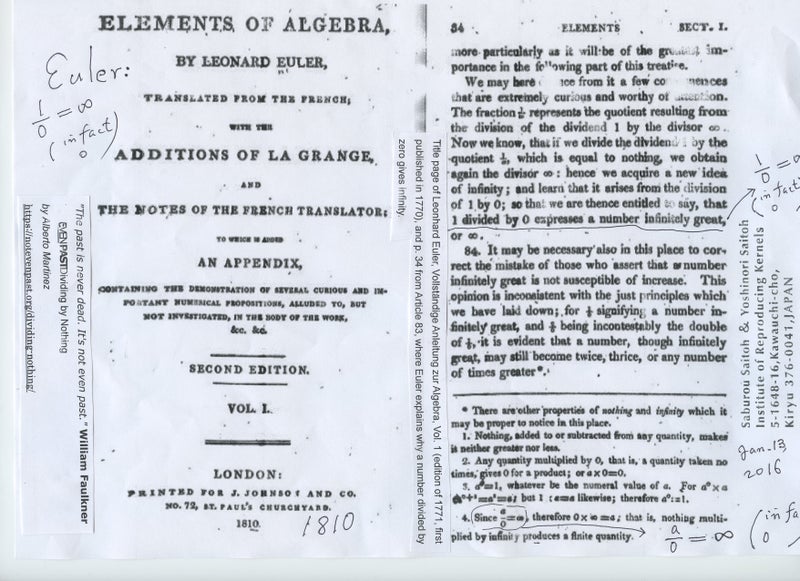



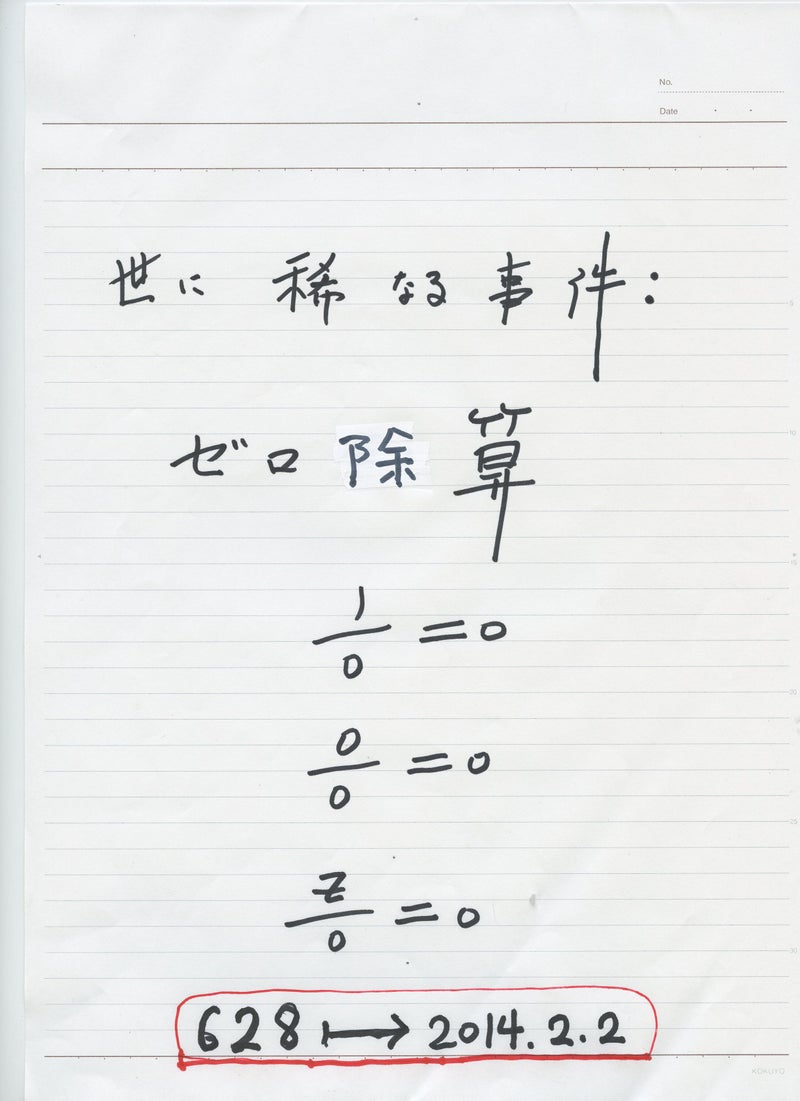








0 件のコメント:
コメントを投稿